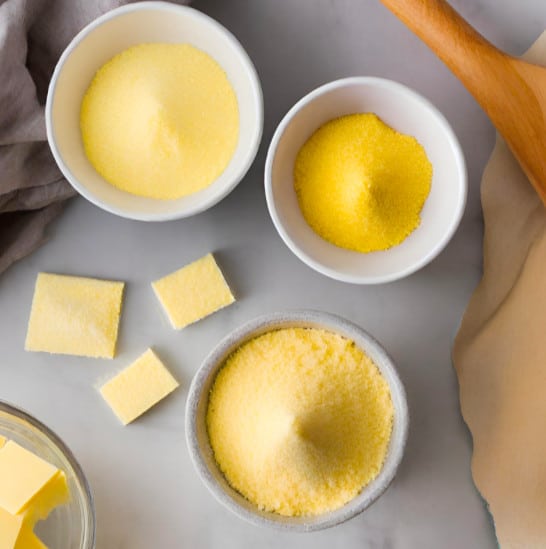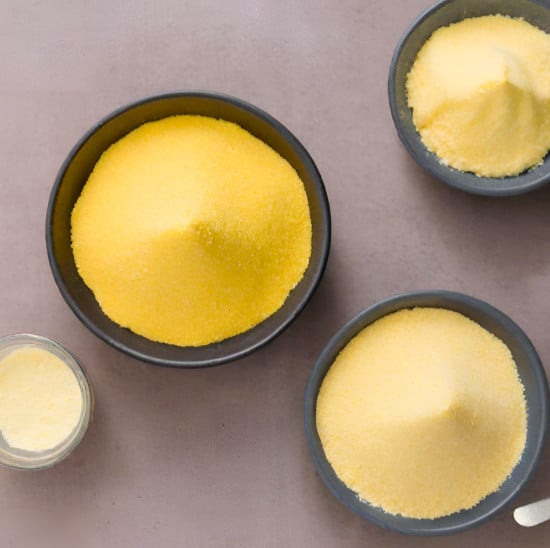
According to a chef, cornmeal substitute is a versatile ingredient that can be used in a variety of dishes, from savory to sweet. It adds a unique texture and flavor to recipes, making it a great alternative for those with dietary restrictions or looking for a new twist on traditional dishes. (1)
And if you’re wondering how to incorporate this substitute into your cooking, keep reading to discover some interesting tips and secrets that will elevate your culinary creations to a whole new level.

KEY TAKEAWAY
What is generally considered the best all-purpose substitute for mimicking both the taste and texture of cornmeal?
Corn grits or polenta are typically regarded as the best overall substitutes for replicating both the flavor and consistency of cornmeal. As coarse whole grains similar to cornmeal, they absorb liquids in the same way and contribute a lightly sweet molasses-like taste and subtle granular quality that represents cornmeal well in a wide variety of applications.
The Most Common Cornmeal Substitutes Explained
When a recipe calls for cornmeal but you don’t have any on hand, don’t panic! There are a few simple substitutes that work great depending on the dish. The most versatile options are masa harina, corn grits, polenta, breadcrumbs, corn flour or cornstarch.
Masa harina impart a strong corn flavor thats perfect for cornbread or tamales.
Corn grits and polenta best mimic cornmeal’s texture, especially in baked goods.
Breadcrumbs work well for coating meats like fried chicken.
Finely ground corn flour or cornstarch can be used but may make the texture more delicate.
You’ll want to choose a substitute based on what qualities of cornmeal your recipe relies on most. For cornbread, you need an ingredient that adds structure and tenderness, making grits or polenta good choices. Whereas masa harina is ideal if you want the unmistakable taste of corn to really shine through. Finely ground substitutes like cornstarch provide mild flavor and are best used in combination with another ingredient for texture.
Which Cornmeal Substitute Is Best for Your Recipe?
When selecting a cornmeal substitute, consider how it will impact the final dish. (2) Masa harina is a top pick if you want strong corn flavor prominence. Its finely ground texture blends into baked goods well. Corn grits create a tender crumb and subtle sweetness that makes them suitable for cornbread. Cracker meal works great for coating fried foods, replicating cornmeal’s crispy exterior nicely.
The type of recipe provides clues on the best swap. Baked goods need texture so grits or polenta is preferable over starch. Meanwhile, thickening sauces calls for something like cornstarch. Often a blend provides the most complete substitution. For instance, combining oats with flour mimics cornmeal better than either alone.
Don’t be scared to experiment – you may discover new favorite combinations!
How to Measure Cornmeal Substitutes for Accurate Replacements
Proper measuring is key when substituting to avoid ruining a recipe. Each cornmeal substitute has a different texture, so replacing it cup for cup won’t always work.
For example, 1 cup cornmeal is equivalent to 1 cup plus 2 tablespoons of cracker meal due to its finer size. Similarly, 1 cup of coarsely ground corn grits or polenta substitutes for 1 cup cornmeal. Finer powders like cornstarch require using 3/4 cup for every 1 cup of cornmeal.
If unsure of measurements, it’s a good idea to do a test run with smaller amounts first. Write down the measurements you use so you can refer back if the outcome is good. Texture is also something to consider – flour will result in a denser product than cornmeal. So you may need to tweak liquid amounts depending on the substitute. With some trial and error, you’ll learn to accurately gauge substitutions.
Tips for Adapting Recipes to Cornmeal Substitutions
Adapting a recipe takes experimentation. Focus first on textures since substitutes don’t always replicate cornmeal perfectly. Liquids may need increasing – cornmeal soaks up more than alternatives like flour.
For instance, if a cornbread recipe seems gummy, try reducing the substitute by 2 tablespoons and adding an extra 1-4 tablespoons of buttermilk. In baked goods, over-mixing after adding a substitute can result in denseness too.
Note how ingredients like starches affect outcomes. Too much cornstarch can make a dish gummy whereas a balanced blend produces the best imitation. Don’t be afraid to tweak baking times if using an unfamiliar substitute as times may need to be longer or shorter. With a few test runs adjusting temperatures and amounts, you’ll learn how to modify recipes for great results with whatever you have on hand.
Can You Really Use Flour as a Cornmeal Substitute?
While flour can fill in when desperate, it’s not the most accurate cornmeal substitute. Flour lacks the subtle sweetness and texture cornmeal lends. All-purpose or whole wheat flour can work in a pinch at a ratio of 1 1/4 cups per 1 cup cornmeal, but the final product may be denser and lack distinct corn flavor. Flour is best used in combination with another ingredient like corn grits or masa harina to mimic cornmeal’s qualities.
However, flour does provide structure and texture if no other alternatives are available. In breads, quick breads or coatings, flour can stand in satisfactorily to allow recipes to be prepared. Just be aware the end result may differ in taste and density from when made with cornmeal.
Overall, flour serves as a suitable last resort if you need a substitute in a real jam but prefer using alternatives when possible.
The Secrets to Creating Cornmeal Texture Without Cornmeal

Grits are one of the best substitutes for replicating cornmeal’s texture without its grittiness. They have a similar light and fluffy texture when cooked. To match the tenderness of cornbread, use 1 cup dairy-free grits mixed with 1/4 cup almond flour in place of cornmeal. The almond flour provides structure like buttermilk or yogurt would. Stir the batter occasionally while baking until the top is lightly browned.
Polenta can also mimic cornmeal well when finely ground. Simply process package polenta in a food processor until it resembles a coarse cornmeal. Toss 1 cup of processed polenta with chicken to coat before frying for cornmeal-crusted thickness and flavor. Bake or fry as usual. The processed polenta delivers an authentically grainy coating that fools the tastebuds.
Avoid These 3 Mistakes When Substituting Cornmeal
Don’t make the mistake of solely relying on flour as a replacement. While it can work, flour tends to result in very dense baked goods rather than the airy texture cornmeal provides. Another common error is failing to adjust liquid amounts. Cornmeal absorbs more moisture than some alternatives, so recipes may need tweaking.
Pay attention to processing substituting ingredients thoroughly too. Under-grinding items like polenta or breadcrumbs results in an unpleasant, gritty mouthfeel. Use a food processor or high-powered blender and process thoroughly until ingredients are broken down but not a paste. Taking the extra few minutes ensures a smoother, polished texture identical to cornmeal.
Popular Ways to Use Cornmeal Substitutes
Cornmeal swap well into recipes for cornbread, muffins, pancakes, waffles and other baked goods. The subtle sweetness and tender crumbs are perfect for these applications.
Polenta makes a great binder substitute for fish cakes or veggie burgers.
Meatloaf and meatballs also welcome cornmeal replacements for added moisture retention and structure.
You can also coat proteins with cornmeal stand-ins. Dredge chicken, pork or tofu pieces in grits, panko or masa harina before pan-frying for crispy exteriors. These substitutes enhance roasts and braised dishes too when used to sop up savory sauces.
With some small adjustments, cornmeal alternatives fit seamlessly into many favorite recipes.
Conclusion
When it comes to finding a substitute for cornmeal, there are several options to consider. Each option has its own unique benefits and flavors, allowing you to experiment and create delicious dishes.
Whether you choose almond meal, coconut flour, or chickpea flour, you can rest assured that these alternatives will provide a satisfying texture and taste. Don’t be afraid to get creative in the kitchen and try out different combinations of these substitutes. By exploring these options, you may discover new flavors and dishes that you never knew existed.
So go ahead, give them a try, and let your culinary adventures begin! Share your experiences and recipes in the comments below.
Frequently Asked Questions
What are some common substitutions for cornmeal?
Popular cornmeal substitutes include masa harina, corn grits, polenta, breadcrumbs, corn flour, cornstarch, cracker meal, ground oats, cooked rice and rice flour. Each provides slightly different texture, flavor or nutritional profile depending on your recipe needs. Masa harina delivers strong corn taste while grits mimic cornmeal’s light density well.
What substitute best mimics cornmeal’s texture and flavor?
Corn grits and polenta are the best substitutes for replicating cornmeal’s flavor and texture. They have a similar gluten-free grainy texture that works well in cornbread and baked goods. Masa harina also imparts robust corn flavor but has a smoother consistency. Breadcrumbs can match cornmeal’s crunchy quality in fried chicken or fish coatings.
Should I use fine or coarse ground substitutes?
Finer substitutes like corn flour or rice flour produce more delicate results while coarse options resemble cornmeal most closely. In general, coarsely ground corn grits, polenta or oats are best suited when texture matters as they mimic cornmeal’s grainy bite. Finely milled versions work better for sauces and baked items.
Can substituting cornmeal affect a dish’s nutrition?
Nutrient profiles may vary slightly according to the replacement ingredient used. Whole grain cornmeal contains fiber, antioxidants and B vitamins. Fine flours lack some nutrients so use coarsely ground or whole alternatives when possible. Masa harina, corn grits and polenta provide minerals like magnesium and iron similarly to cornmeal.
What can I use if I have dietary restrictions?
Those avoiding gluten can opt for masa harina, grits, corn starch or gluten-free oat flour. Almond or coconut flour also work well, though they alter flavor subtly. Rice flour offers gluten-free and nut-free substitution. Check product labels if concerned about allergens like corn or dairy in some alternatives like polenta. Experimentation helps find suitable swaps.
Do measurements matter when substituting?
Yes, measurements impact results. Finer options like corn flour require 3/4 cup per 1 cup cornmeal due to density. Meanwhile, 1 cup coarse grits or polenta substitute 1 cup cornmeal. Always do test runs with small amounts first when measuring alternatives for dense baked goods or sauces. Adjustments may be needed if using an unfamiliar ingredient.
How do I know if a substitute works?
Focus on texture and taste initially. The substitute should mimic cornmeal’s crumbly texture when raw and leave flecks in baked goods. Polenta and grits often perform best but masa also succeeds. Flour makes chewier items. Consider tweaking liquids if using a thirstier option. Monitor carefully as substitutes can alter cooking times slightly too. With practice, you’ll know what swaps work well for different recipes.
Was this helpful?

I’m Mary R. Q. , a seasoned professional chef dedicated to elevating home cooking experiences. Through my expertise in the culinary arts, I provide practical cooking tips and insightful reviews of kitchen utensils on my blog, milkwoodrestaurant.com. As a passionate advocate for transforming everyday meals into extraordinary culinary adventures, I aim to empower home cooks with the knowledge and tools they need to create delicious and memorable dishes. I’m also an author of the book “1,001 Kitchen Tips & Tricks: Helpful Hints for Cooking, Baking, and Cleaning (1,001 Tips & Tricks)” which is sold on Amazon. Join me on a flavorful journey as we explore the art of cooking and the essential tools that make it a joy.







